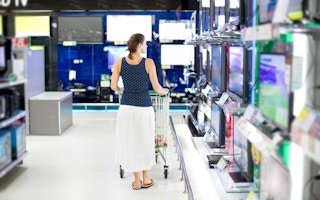In the next five years, people in Singapore will be ten times more interested in purchasing “connected home” products which monitor energy consumption in real time and allow users to control their appliances remotely using mobile apps. While six per cent of consumers today own connected home products, interest in these technologies is expected to rise to 68 per cent by 2019.
To continue reading, subscribe to Eco‑Business.
There's something for everyone. We offer a range of subscription plans.
- Access our stories and receive our Insights Weekly newsletter with the free EB Member plan.
- Unlock unlimited access to our content and archive with EB Circle.
- Publish your content with EB Premium.
At the same time, demand for solar panels will also multiply more than tenfold from five per cent today to 58 per cent.
Lower energy bills and increased comfort and convenience are the main reasons behind these changing consumer preferences, according to analysis released by management consulting firm Accenture on Monday.
The Singapore-specific findings are part of Accenture’s global survey, entitled ‘The New Energy Consumer: Architecting for the Future’, which was launched in New York on June 23. The survey polled 13,000 individuals across 26 countries, including 500 from Singapore.
The survey’s findings from Singapore-based respondents found that these changing consumer preferences present big business opportunities for the city-state’s energy providers to expand their product offerings and market share.
However, there are major gaps in their business models and operations that these companies must fill to capitalise on these opportunities.
Greg Guthridge, managing director of Accenture’s utilities industry group, said that Singapore’s energy companies already enjoyed a positive perception amongst consumers, with 60 per cent of respondents declaring a “strong trust” in energy providers to provide information on reducing energy usage.
Energy providers also benefit from a tendency amongst consumers to stick with one provider for all their energy needs. The survey found that 79 per cent of consumers prefererred to have a single provider when considering new monitoring and control products and services, while 74 per cent would prefer to buy solar products and services from their existing energy providers as well.
Energy providers could capitalise on this existing trust and retain consumers even as their energy preferences changed by expanding the range of products and services they offered, said the survey.
In addition to providing electricity and gas to users, they could provide solar installation services, connected home products, electric vehicle charging, and home maintenance, amongst others.
Digital dissatisfaction
“
Energy providers need to take the hassle out of consumer interactions and make them as simple, accessible and convenient as possible. This will become even more critical as connected-home solutions gain mass appeal.
Greg Guthridge, managing director, Accenture utilities industry group
Energy providers could also improve the quality of online engagement they offer their customers, Guthridge said.
He said: “In these nascent, rapidly expanding and converging markets, the opportunity to capture market share is a wide-open field. Success will come down to those providers who perfect the digital customer experience.”
Survey findings showed that consumers increasingly preferred to carry out administrative transactions related to their energy usage online, such as changing home addresses, signing up for new services and resolving billing issues.
Using digital channels to interact with the company actually increased customer satisfaction. The survey found that 72 per cent of digital channel users reported being satisfied with their providers, compared to satisfaction rates of 67 per cent amongst non-digital users.
However, 73 per cent of Singapore consumers polled said they faced challenges when using the online customer portals of these companies. The most common complaint was that the pages took too long to load.
In addition to improving loading speeds, energy companies would also need to improve the overall quality of their websites, as more than 80 per cent of respondents expected their energy providers to match or exceed the web experience offered by online retailers, banks and even government agencies.
“Many utilities still compare their service levels to other utilities, but our research shows that they need to look to other providers’ digital experiences”, noted Guthridge.
He added that “energy providers need to take the hassle out of consumer interactions and make them as simple, accessible and convenient as possible. This will become even more critical as connected-home solutions gain mass appeal”.
Almost 70 per cent of respondents cited energy efficiency as the main reason for purchasing connected home technology, which allows consumers to link a number of devices through one centrally controlled system, monitor their energy usage in real time, and have more convenient control of their devices.
The survey recommended a wide range of enhancements that energy providers could make to their online presence to meet the needs of consumers. These included sending real time notifications for power outages, payment deadlines and above-average energy consumption rates, and allowing consumers to log in using their social media accounts.
Energy providers would have to move quickly to gain a competitive advantage over emerging business models, noted Guthridge.
He added that the digital revolution was creating areas where the digital and energy sectors overlapped, and that this was “creating new opportunities to provide new, interconnected platforms for innovation that bring the connected-home, electric vehicles and alternative energy sources together”.
“With traditional business models at risk, leading energy providers will need to move quickly to differentiate from new entrants”, he said.










